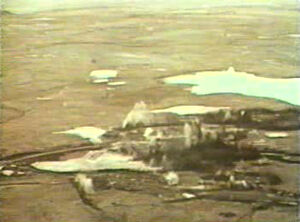Long Shot (nuclear test) (nonfiction): Difference between revisions
No edit summary |
No edit summary |
||
| (2 intermediate revisions by the same user not shown) | |||
| Line 1: | Line 1: | ||
[[File:Long_Shot_film_still.jpg|thumb|Film still from a DOE film about Project Long Shot, part of the Amchitka testing program. The dirt is being displaced by an 80 kiloton nuclear test.]]'''Long Shot''' (or '''Flintlock Long Shot''') was a nuclear | [[File:Long_Shot_film_still.jpg|thumb|Film still from a DOE film about Project Long Shot, part of the Amchitka testing program. The dirt is being displaced by an 80 kiloton nuclear test.]]'''Long Shot''' (or '''Flintlock Long Shot''') was a nuclear weapon test by the United States at Amchitka, Alaska on October 29, 1965. | ||
== Description == | == Description == | ||
| Line 28: | Line 28: | ||
<gallery> | <gallery> | ||
Long_Shot_nuclear_test_at_Amchitka_-_29_Oct_1965.png|Long Shot nuclear weapons test: image with date, location, maps. | |||
</gallery> | </gallery> | ||
Latest revision as of 19:14, 29 October 2020
Long Shot (or Flintlock Long Shot) was a nuclear weapon test by the United States at Amchitka, Alaska on October 29, 1965.
Description
To conduct the Vela Uniform test Long Shot, the Department of Defense occupied Amchitka from 1964 to 1966, with the AEC providing the device, measuring instruments, and scientific support. The goal was "to determine the behavior and characteristics of seismic signals generated by nuclear detonations and to differentiate them from seismic signals generated by naturally occurring earthquakes."
Although it would not be publicly announced until March 18, 1965, senior Alaskan officials were notified the previous February. After the devastating Great Alaska earthquake of March 27, 1964, the governor expressed concern about the psychological effects of the test on the populace. He was quickly reassured.
Long Shot was detonated on October 29, 1965, and the yield was 80 kilotons (330 TJ). It was the first underground test in a remote area, and the first test managed by the DoD. While there was no surface collapse, tritium and krypton were found at the surface following the test; this was not made public until 1969.
Background
Long Shot was part of the Project Flintlock series of 47 nuclear weapons tests, which occurred at various sites. Flintlock was administered under Vela Uniform, an element of Project Vela, undertaken by the United States Department of Defense to develop and implement methods to monitor compliance with the 1963 Partial Test Ban Treaty.
Amchitka was selected by the United States Atomic Energy Commission to be the site for underground detonations of nuclear weapons. Three such tests were carried out:
- Long Shot, an 80-kiloton (330 TJ) blast in 1965;
- Milrow, a 1-megaton (4.2 PJ) blast in 1969;
- Cannikin in 1971 – at 5 Mt (21 PJ), the largest underground test ever conducted by the United States.
The tests were highly controversial, with environmental groups fearing that the Cannikin explosion, in particular, would cause severe earthquakes and tsunamis.
Amchitka is no longer used for nuclear testing.
Amchitka is still [October 2020] monitored for the leakage of radioactive materials.
In the News
Fiction cross-reference
- Crimes against physical constants
- Gnomon algorithm
- Gnomon Chronicles
- Project Vale - an attempt to communicate with AESOP using Latin by the Future Disciples of Julius Christ
Nonfiction cross-reference
- Cannikin (nonfiction)
- Project Vela (nonfiction) - element of Project Vela conducted jointly by the United States Department of Energy and the Advanced Research Projects Agency. Its purpose was to develop seismic methods for detecting underground nuclear testing, and it involved many experts from academia, the sponsoring military agencies and the Atomic Energy Commission.
- Vela Uniform (nonfiction) - project undertaken by the United States Department of Defense[1] to develop and implement methods to monitor compliance with the 1963 Partial Test Ban Treaty. This treaty banned the testing of nuclear weapons in the atmosphere, in outer space, and underwater, effectively meaning nuclear tests were only to be permitted underground.
External links
- Amchitka
- Cannikin @ Wikipedia
- Vela Uniform @ Wikipedia
- Project Vela @ Wikipedia

